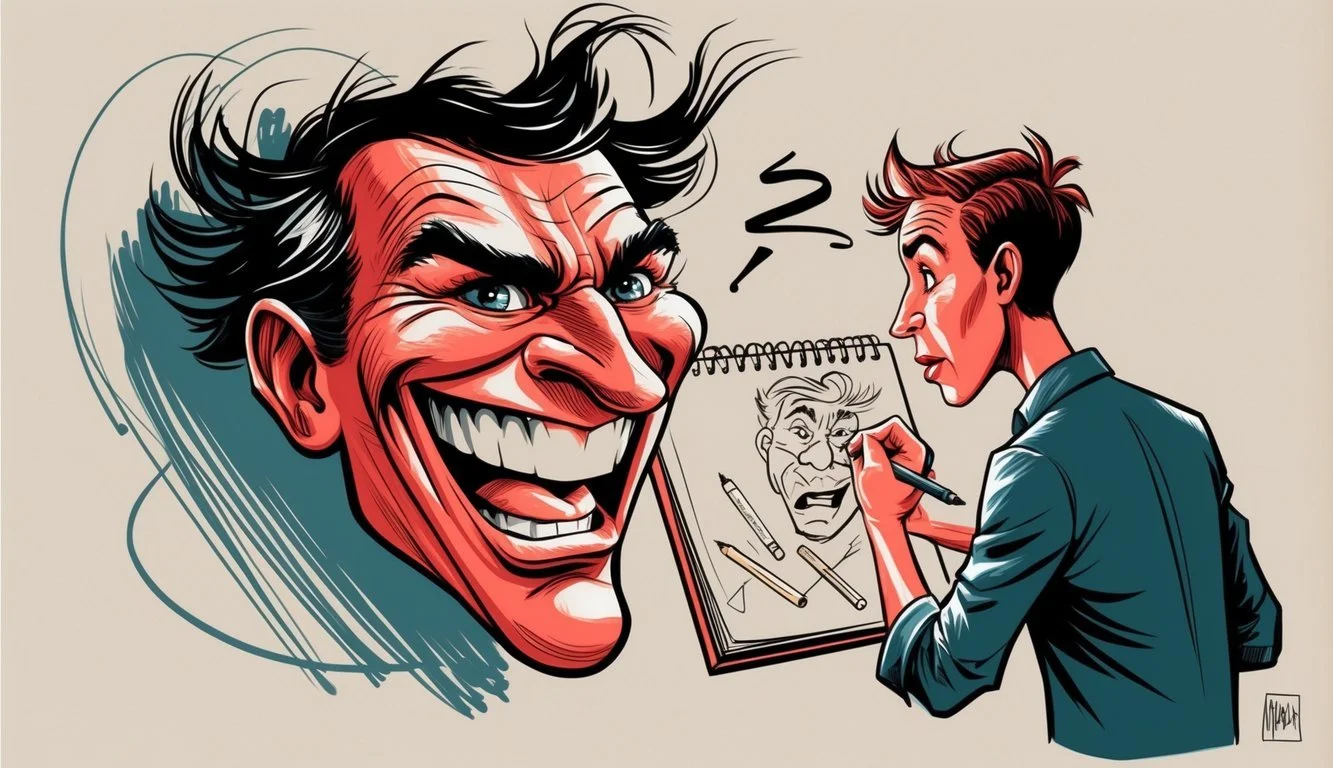Reading Impulsivity: How Facial Expressions Reveal Emotional States in ADHD
Facial expressions provide valuable insights into a person's emotional state and cognitive processes. For individuals with attention-deficit hyperactivity disorder (ADHD), these nonverbal cues can be particularly telling when it comes to impulsivity. Recent research has shed light on the connection between impulsive behaviors and specific facial expressions in those with ADHD.
Studies have shown that children with ADHD often display distinct facial expressions related to impulsivity, such as rapid changes in emotional states or exaggerated reactions to stimuli. These expressions can manifest as sudden shifts in facial muscles, widened eyes, or quick changes in mouth positioning. Understanding these visual indicators can help parents, educators, and healthcare professionals better recognize and address impulsive tendencies in individuals with ADHD.
Innovative diagnostic tools are now being developed to assess impulsivity through facial expression analysis. These technologies utilize machine learning algorithms to detect micro-expressions and identify emotional states associated with impulsive behaviors. By combining traditional assessment methods with these cutting-edge tools, clinicians can gain a more comprehensive understanding of an individual's impulsivity levels and tailor treatment approaches accordingly.
Understanding Impulsivity
Impulsivity is a complex behavioral trait characterized by quick, unplanned reactions without consideration of consequences. It involves neurological, psychological, and environmental factors that influence decision-making and actions.
Definition of Impulsivity
Impulsivity refers to the tendency to act hastily without adequate forethought or planning. It manifests as rapid, unplanned responses to internal or external stimuli, often disregarding potential negative outcomes. Impulsive behaviors can range from interrupting conversations to making rash financial decisions or engaging in risky activities.
Key components of impulsivity include:
Lack of premeditation
Difficulty delaying gratification
Reduced inhibitory control
Sensation-seeking tendencies
These elements contribute to the multifaceted nature of impulsive behavior, affecting various aspects of daily life and interpersonal relationships.
Psychological Perspectives on Impulsivity
Psychologists view impulsivity through different theoretical lenses, each offering unique insights into its underlying mechanisms and manifestations.
Cognitive perspective: Focuses on information processing and decision-making deficits associated with impulsivity. It examines how individuals with high impulsivity may struggle to weigh consequences effectively or consider long-term outcomes.
Behavioral approach: Emphasizes the role of reinforcement and learning in shaping impulsive behaviors. This view suggests that immediate rewards often outweigh delayed, larger rewards for impulsive individuals.
Neurobiological standpoint: Investigates the brain structures and neurotransmitter systems involved in impulse control. The prefrontal cortex, which governs executive functions, plays a crucial role in regulating impulsive tendencies.
Impulsivity in Behavioral Disorders
Impulsivity is a prominent feature in several mental health and behavioral disorders. Its presence can significantly impact diagnosis, treatment, and prognosis.
Attention-Deficit/Hyperactivity Disorder (ADHD): Impulsivity is a core symptom, often manifesting as interrupting others, difficulty waiting one's turn, or making hasty decisions.
Substance Use Disorders: Impulsive traits can increase vulnerability to addiction and complicate recovery efforts. Individuals may struggle with resisting cravings or controlling substance intake.
Borderline Personality Disorder: Impulsivity in this context often involves risky behaviors, self-harm, or sudden changes in relationships or life goals.
Bipolar Disorder: During manic episodes, individuals may exhibit heightened impulsivity, leading to reckless spending, risky sexual behavior, or ill-considered business ventures.
Understanding impulsivity in these disorders is crucial for developing targeted interventions and support strategies.
Facial Expressions as Non-Verbal Cues
Facial expressions serve as powerful non-verbal cues in human communication. They convey emotions, intentions, and reactions without the need for words. These subtle movements of facial muscles provide valuable insights into a person's inner state and social interactions.
Role of Facial Expressions in Communication
Facial expressions play a crucial role in transmitting information during social interactions. They can reinforce, contradict, or substitute spoken words. Research suggests that facial cues account for a significant portion of social meaning in neurotypical settings.
Expressions like smiles, frowns, and raised eyebrows often communicate more effectively than verbal statements. They help establish rapport, show empathy, and signal agreement or disagreement.
In early childhood development, facial expressions are fundamental. Infants learn to interpret and respond to facial cues long before they can speak, forming the basis for social and emotional intelligence.
Analysis of Microexpressions
Microexpressions are brief, involuntary facial movements that reveal true emotions. These fleeting expressions typically last less than a second and are often difficult to detect without training.
Experts in nonverbal communication can identify seven universal microexpressions: happiness, sadness, anger, fear, disgust, surprise, and contempt. Each involves specific muscle movements and conveys distinct emotional states.
Analyzing microexpressions can provide valuable insights in various fields, including psychology, law enforcement, and business negotiations. They can reveal hidden feelings or intentions that contradict spoken words, offering a deeper understanding of an individual's true emotional state.
Linking Impulsivity and Facial Expression
Impulsivity and facial expressions are interconnected aspects of human behavior and communication. Research indicates a bidirectional relationship between impulsive tendencies and the way individuals process and display facial emotions.
Impulsive Facial Responses
Impulsive individuals often exhibit rapid and intense facial reactions to emotional stimuli. These quick responses can manifest as exaggerated expressions or sudden changes in facial muscles. Studies have shown that people with higher impulsivity scores tend to display more pronounced reactions to both positive and negative emotional cues.
Facial electromyography (EMG) measurements have revealed increased muscle activity in impulsive subjects when viewing emotional images or faces. This heightened reactivity suggests a lower threshold for emotional expression in impulsive individuals.
Some researchers propose that this enhanced facial responsiveness may be linked to difficulties in emotion regulation, a common characteristic of impulsivity.
Facial Expressions Indicative of Impulsive Behavior
Certain facial expressions can serve as indicators of impulsive tendencies. Rapid changes in expression, especially in response to frustration or excitement, may signal impulsive traits. Microexpressions - brief, involuntary facial movements - can be particularly telling.
Studies using facial recognition software have identified specific patterns associated with impulsivity:
Frequent shifts between emotional states
Intense expressions of anger or joy
Reduced control over facial muscles during emotional tasks
Researchers have also noted differences in how impulsive individuals process others' facial expressions. They may show reduced accuracy in recognizing subtle emotional cues, potentially contributing to social difficulties often associated with impulsivity.
These findings highlight the complex interplay between impulsivity and facial expressions in human social interactions and emotional processing.
Research and Findings
Studies on impulsivity and facial expression recognition have yielded important insights into human behavior and cognition. This research explores the links between impulsive tendencies and the ability to accurately perceive emotions in others' faces.
Empirical Studies on Impulsivity
Research has shown that impulsive individuals often exhibit difficulties in emotional processing. One study found that impulsive adolescents with borderline personality disorder symptoms tend to make rapid but inaccurate judgments about others' emotional states. This tendency can lead to misinterpretations in social interactions.
Another investigation revealed that individuals with higher levels of emotion-related impulsivity struggle more with response inhibition tasks. However, arousal was found to improve behavioral response inhibition in non-clinical populations.
Facial Expression Recognition in Psychological Research
Facial expression recognition plays a crucial role in social interactions and emotional intelligence. Studies have examined how different emotional expressions impact cognitive processes like inhibitory control.
Research on alcohol binge drinkers has produced mixed results regarding emotional processing. Some evidence suggests that higher levels of binge drinking may be associated with subtle biases in rating ambiguous facial expressions.
Scientists have also explored the relationship between alexithymia, impulsivity, and facial expression recognition. This research aims to uncover potential links between emotional awareness, impulsive behaviors, and the ability to accurately interpret others' emotions.
Measuring Impulsivity and Facial Expression
Assessing impulsivity and analyzing facial expressions involves specialized tools and technologies. These methods provide valuable insights into behavior and emotional responses.
Assessment Tools for Impulsivity
The Barratt Impulsiveness Scale (BIS) is a widely used self-report measure for evaluating impulsivity. It consists of 30 items scored on a 4-point Likert scale, from 1 (rarely/never) to 4 (almost always).
Behavioral tasks complement self-report questionnaires in measuring impulsivity. These tasks often require participants to respond quickly to stimuli, allowing researchers to observe impulsive tendencies in action.
Researchers may use a combination of self-report and behavioral measures to gain a more comprehensive understanding of impulsivity. This multi-method approach helps capture different aspects of impulsive behavior.
Technology in Analyzing Facial Expressions
Facial expression analysis software employs machine learning algorithms to detect micro-expressions. This technology can identify subtle changes in facial muscles that may indicate emotional states.
Some systems can distinguish between hypo-expressive and hyper-expressive individuals. Hypo-expressive people may show reduced facial expressions, while hyper-expressive individuals display more intense emotional reactions.
Advanced software can track dynamic facial expressions over time. This capability allows researchers to observe changes in emotional responses throughout an interaction or experiment.
Correlations between facial expressions and impulsivity measures provide valuable data. For example, certain facial movements may be linked to higher scores on impulsivity scales.
Implications and Applications
Facial expressions and impulsivity intersect in ways that significantly impact human behavior and interactions. This connection has far-reaching implications across various domains of life and society.
Impact on Social Interactions
Facial expressions serve as crucial nonverbal cues in social settings. Impulsive individuals may display more intense or rapidly changing facial expressions, potentially affecting how others perceive and respond to them. This can lead to misunderstandings or strained relationships.
People with high impulsivity might struggle to maintain a neutral expression, inadvertently revealing their emotions more readily. This openness can foster deeper connections but also make them more vulnerable in certain situations.
Conversely, those adept at recognizing facial cues may be better equipped to navigate social interactions with impulsive individuals, anticipating their reactions and adjusting their approach accordingly.
Relevance in Clinical Contexts
The link between facial expressions and impulsivity holds significant value in clinical settings. Therapists and mental health professionals can use facial cues to gain insights into a patient's impulsive tendencies and emotional state.
This connection is particularly relevant in diagnosing and treating conditions associated with impulsivity, such as ADHD, borderline personality disorder, and certain mood disorders. Facial expression analysis could potentially serve as a non-invasive diagnostic tool.
Treatment approaches may incorporate facial feedback techniques to help individuals manage impulsive behaviors. For example, practicing specific facial expressions could aid in emotion regulation and impulse control.
Applications in User Interface Design
Understanding the relationship between facial expressions and impulsivity can inform the development of more intuitive and responsive user interfaces. Designers can create systems that adapt to users' emotional states and impulsive tendencies.
For instance, gaming interfaces could adjust difficulty levels or pacing based on a player's facial expressions, providing a more tailored and enjoyable experience. Similarly, educational software might adapt its content delivery rate to match a student's attention span and impulsivity level.
Facial recognition technology in vehicles could potentially detect signs of impulsive behavior or distraction in drivers, enhancing road safety. This application extends to other high-stakes environments where impulsivity could pose risks.
Conclusion
Impulsivity plays a significant role in how adolescents process and interpret facial expressions. Research indicates that impulsive teens, especially those with borderline personality disorder symptoms, are more prone to errors when assessing emotional states from faces.
This tendency can exacerbate interpersonal conflicts and social difficulties. The rapid, inaccurate judgments made by impulsive adolescents may stem from inefficient processing of facial cues.
Studies suggest a link between higher impulsivity and reduced neural responses to emotional changes in faces. This attenuated processing could result from weaker connections between frontal and occipital brain regions.
These findings highlight the importance of addressing impulsivity in adolescents to improve their social cognition skills. Interventions targeting impulse control may help vulnerable youth navigate social interactions more effectively.
Future research should explore specific strategies to enhance facial expression recognition in impulsive teens. This could lead to better outcomes in their interpersonal relationships and overall social functioning.





